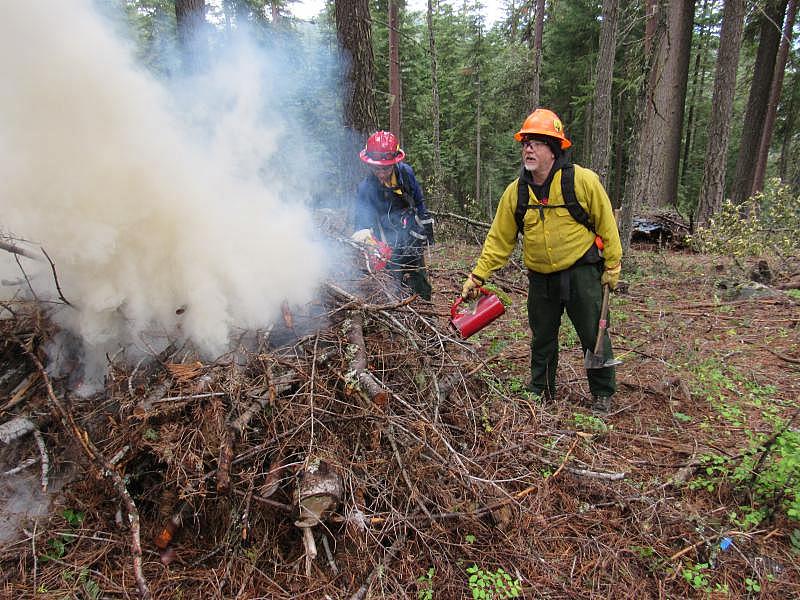Oppressed By Wildfire: Weaving Culture Into Fire Management Helps Tribes Reclaim Suppressed Heritage
This story was produced as a project for the 2019 California Fellowship, a program of USC Annenberg's Center for Health Journalism.
Other stories in this series include:
Oppressed By Wildfire: Language Barriers, Unwelcoming Attitudes Discourage Latinos From Seeking Help
Oppressed By Wildfire: Disabilities Challenge Some Victims' Evacuations And Their Recovery
Oppressed By Wildfire: Homeless People Left Out Of Federal Disaster Aid Programs

APRIL EHRLICH | JPR NEWS
Wildfire isn’t always a bad thing. In fact, fire has been an integral part of Native American culture for centuries as a tool to keep forests healthy.
That’s part of the reason why Rick O’Rourke loves starting forest fires; prescribed ones, that is. O'Rourke is a firefighter and a member of the Yurok Tribe. During an overcast morning in mid-May, O’Rourke stomps around piles of forest debris in the Ashland Watershed in Southern Oregon, using a “drip torch” to set them aflame
“See that? We did that!” he yells.
Prescribed burns are a means of thinning forests so they’re more resistant to deadly wildfires. O’Rourke traveled from Humboldt County to train in prescribed burning with a program called TREX. It’s run by the nonprofit Nature Conservancy and it teaches firefighters how to safely use fire as a tool to manage overgrown forests.
For O’Rourke, working with fire runs in his blood.
“Fire to the Yurok people has been a management tool since the beginning of creation, since we were put into our lands and shown how to tend it in the original agreement with our creator,” O’Rourke says.
Centuries of living on and adapting to their land taught Native Americans to start fires at certain times of the year to keep fuel loads down. The smoke and ash, in turn, killed bugs and pests that infected trees and their crops.
University of Oregon professor and sociologist Kari Marie Norgaard says native cultural burns essentially stopped after Western colonization.
“It was made illegal, in fact,” Norgaard says. “There are materials that talk about how people should be shot for setting fires. It was a very intense violence that was enacted on people in the process of fire suppression.”
Norgaard has researched how federal fire suppression affected the Karuk Tribe in the Klamath Basin in Northern California. She says the impact was multifaceted. Most of the tribe’s traditional foods, regalia and medicinal plants can only come from a diverse landscape that interacts with fire.
“There are ways that traditional knowledge is being reproduced when people are out on the landscape doing burns,” Norgaard says. “There are ways that interactions between elders and young people and all kinds of social values are passed on through the practice of burning.”
Karuk Tribe spokesman Craig Tucker says federal forest management practices in the basin were initially influenced, in part, by money.
“There was a lot of pressure on these forests to churn out board feet of timber,” Tucker says. “So there was this big economic incentive.”
That incentive, Tucker adds, resulted in an unhealthy forest that was more susceptible to catastrophic wildfires.
And when Native Americans are hit with a wildfire, they are hit with the most long-lasting impacts. That’s the conclusion of a 2018 study by the University of Washington and the Nature Conservancy, which found that Native Americans were most vulnerable to wildfires.
Tucker says he’s not surprised by the study’s conclusions for economic reasons.
“Around 90 percent of Karuk tribal members who live along the Klamath River live below the poverty level,” Tucker says. “So when there’s a wildfire, when the smoke is really bad, people can’t afford to move into a hotel for a week.”
Researcher Ian Davies led the study. He says wildfires leave the most disastrous impacts on marginalized communities.
“If you’re a renter, if you’re poor, if you have a disability, those things really compound the difficulty of not only preparing for and adapting to wildfire but recovering from it afterwards,” he says.
Davies found that census tracts that were most economically vulnerable to wildfires correlated with ethnicity — so not only are Native Americans more susceptible to long-term wildfire damages, so are Latinos and African Americans.
Besides socioeconomic factors, culture also plays a role.
“People who identify as the same race or ethnicity, they have shared culture and shared perceptions and shared histories,” Davies says.
And he says governments often don’t take those perceptions into consideration when preparing for or responding to disasters. For instance, the National Guard is usually deployed to areas during a major wildfire, but people of color, particularly immigrants, are often wary of these heavily armed officials at street checkpoints.
Back at the prescribed burn training, Rick O’Rourke says that’s what makes the Yurok Tribe successful at mitigating wildfire; it weaves in culture and shared tribal knowledge into forest management.
“Fire is pulling our community together,” he says. “It’s not just healing the land. It’s healing our people.”
O’Rourke says he’ll bring what he learned from this training to his friends and family on the California coast, so Yurok tribal members could continue to live on their land and manage it the way their ancestors learned long ago.
[This article was originally published by Jefferson Public Radio.]

